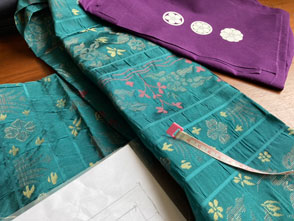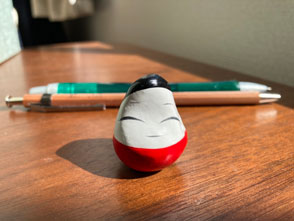Atelier AOBA Corp.
Atelier AOBA was founded in 2014 in the city of Sendai of Miyagi prefecture in Japan. We are dedicated to creating high quality, sophisticated, one of a kind evening bags using beautiful Japanese traditional silk woven textiles as those used in kimono.
The art of Kimono is a cultural gift inherited from over1400 years of Japanese history. Atelier AOBA’s passion is to deliver the beauty of Japanese traditional arts and the spirit of craft workers to the world by integrating modern style and traditional arts into our works.
SENDAI CITY
Sendai is the capital of the Miyagi prefecture. Until 1943 there was a castle on top of the hill overlooking the city. Shogun-Masamune Date built this castle and called it Sendai castle. It is also known as Aoba castle, a name reflecting its elegance from the green leaves (Aoba in Japanese) surrounding the castle. “Sendai” is named from a temple that existed in the same location as where the castle was constructed. The temple had one thousand (one thousand is “SEN” in Japanese) Buddha sculptures, therefore the temple was called “Sendai” temple.
In the present day, the city of Sendai has developed into a modern city with a population of over 1,080,000. Sendai is also known as the city with beautiful green trees. (It is also called “Mori no Miyako”- Capital of Green Forest in Japanese). It was so named because the city is surrounded by hills and mountains, and many maple and zelkova trees were planted along the main streets. Shogun Masamune started planting these trees as a part of an urban planning project in the 16th century.
Our corporation’s name “Atelier AOBA” also was inspired by these “green leaves”. Our vision as a company is to start growing as young green trees that will become big trees where many people come to enjoy, relax and rest under the shade of our fresh green leaves.
“The oak sleeps in the acorn; the bird waits in the egg; and in the highest vision of the soul a waking angel stirs. Dreams are the seedlings of reality.”
— James Allen, As a Man Thinketh
News letter from Double Petal
I would like to receive the information about new products, seasonal events and news of Double Petal. By signing up, I accept the terms of Atelier AOBA’s privacy policy.






Designer’s profile
Sayuri Daita
Sayuri was born in Nara prefecture, the ancient capital of Japan, surrounded by many old temples, rice fields, and hills.
Continued….
She has absorbed the love for the old Japanese culture in its most primitive way from her hometown. Sayuri then moved with her parents and grew up in Yokohama City, the biggest harbor town in Japan. Growing up in this gateway to Japan, Sayuri got to see many exotic overseas cultures. She saw old European style architecture that was built more than 100 years ago when Japan opened its door to trade, after 200 years of the closed trading period.
“Seeing business people from all over the world, watching big container ships coming in and leaving the harbor, having lunch in Chinatown was my daily routine with my family.”
Receiving many antique kimonos of early Showa and Taisho era as inherited presents from her aunt, Sayuri enjoyed wearing them on many occasions from wedding parties, tea ceremonies, and casual outings.
When studying and living abroad, she found a lot of people were amazed and loved the beauty of Kimono. Many were interested to know the meaning of each pattern, the background, and styles. With this, Sayuri got inspired to create a clutch bag for women who adore the beauty of Kimono. She hopes to preserve the culture of Kimono cloth making by encouraging more uses for them. Her hope is that when her Kimono clutch bags become a hit, the tradition of Kimono cloth making and culture will continue through time in a new form.
Passion, Drive, and Inspiration
Kimono represents an abundance of life and sustainability as it is inherited within the family. Now the culture will be extended from Japan to the world.
From the start, I did not do this Kimono business to earn my cost of living, I had another business already started a few years before. The idea to make modern style clutch bags with Kimono for ladies in all over the world has just been crystallized in my mind when I thought I wanted to start a business in the Tohoku region. I felt like I have been led by someone’s hands to create this business…maybe it was an inheritance of passion and knowledge from my ancestors. My grandfather owned an importing business of Western hats in Kobe. My great grandmother who worked at Fukuyama castle was a tea-ceremony teacher in Hiroshima. My grandmother was a skilled Kimono making teacher. My grandfather’s family migrated to the USA when they were young. As a result, we have Japanese American relatives. My father’s cousin is a flower arrangement teacher. As for me, I learned the Japanese flower arrangement called ‘Ikebana’ as a teenager. I also learned Japanese tea ceremonies called ‘Sado’. I continued these lessons in France, the USA, and Switzerland. During the time I lived in those countries, I met many local friends who admire the beauty of Japanese culture and Kimono. That inspired me to create the artistic piece of product.
I grew up in a family where Japanese culture and Western culture met. It was a unique upbringing. It allowed me to see the beauty of different cultures. I am happy and grateful for my family roots, for the people who expressed their interest in Kimono, for all my friends all over the world who helped me so much to create this project. Without their help I could not do this.
I believe this project will contribute to the abundance and sustainability of Kimono.
Kimono had been influenced by many different cultures like the global silk road and it owes their beauty to countless people in many countries who had been preserving and nurturing them over a few centuries. These beautiful pieces were forms of love that people created. I also wish this project contributes to making the world a peaceful and harmonious place by appreciating the beauties of many different cultures around the world.
With love and gratitude,
Sayuri

×



